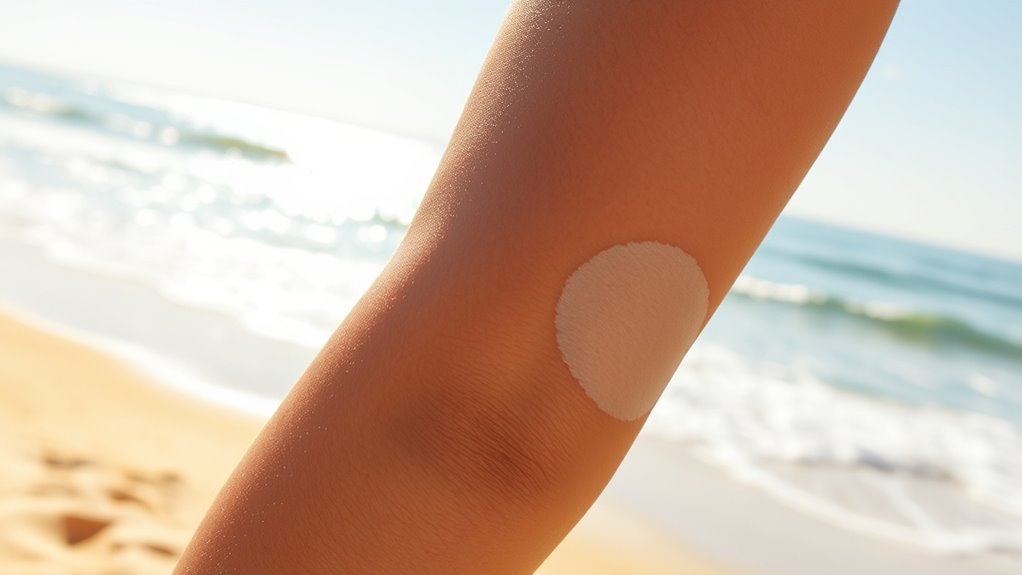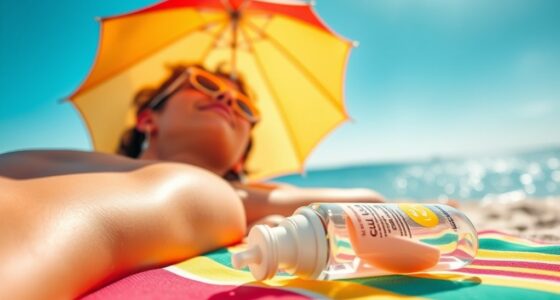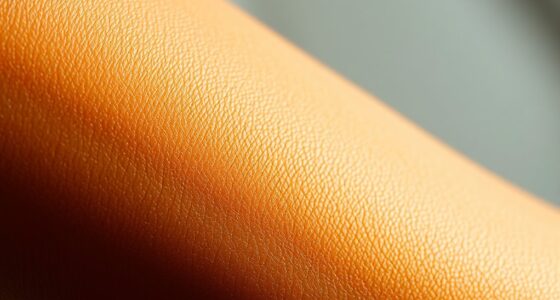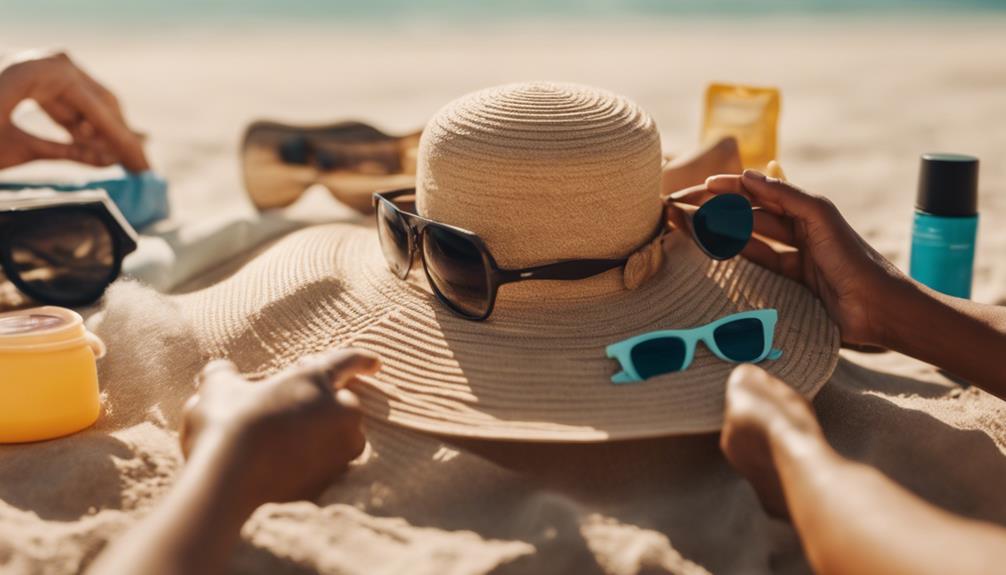Indoor tanning exposes your skin to UVA and UVB rays that damage DNA and increase your risk of skin cancer, including basal cell carcinoma, squamous cell carcinoma, and melanoma. Starting young or frequent sessions boost these risks and can lead to premature skin aging. Despite declining popularity, many young adults still tan, influenced by appearance and social factors. Protecting your skin with sunscreen, shade, and protective clothing can help, and understanding more about these dangers could change your perspective.
Key Takeaways
- Indoor tanning emits UV radiation comparable to or stronger than sunlight, significantly increasing skin cancer risk.
- Early UV exposure from tanning boosts lifetime chances of melanoma, basal cell carcinoma, and squamous cell carcinoma.
- Tanning before age 20 raises melanoma risk by nearly 50%, with higher risks for frequent or indoor tanning.
- Public health initiatives promote protective behaviors like sunscreen, shade, and limiting tanning to reduce skin cancer cases.
- Laws restricting minors’ access to tanning beds aim to prevent early UV damage and decrease future skin cancer incidence.
How Indoor Tanning Raises Skin Cancer Risks

Indoor tanning considerably increases your risk of skin cancer because the devices emit UVA and UVB radiation that damage your skin cells’ DNA. These rays penetrate your skin, causing mutations that can lead to various types of cancer, including basal cell carcinoma, squamous cell carcinoma, and melanoma. Using tanning beds before age 20 raises your risk even more—by 50% for BCC and over 100% for SCC—because your skin is more vulnerable during youth. Indoor tanning exposes you to levels of UV radiation comparable to or stronger than the sun, actively damaging your skin with every session. The World Health Organization classifies UV radiation from these devices as a carcinogen, confirming the direct link between indoor tanning and increased skin cancer risk. Understanding the risks helps emphasize the importance of protecting your skin from UV exposure. Additionally, UV radiation exposure can weaken your immune system, making it harder for your body to fight off skin cancer cells. Recognizing tanning device radiation levels as potentially harmful underscores the need for safer alternatives to tanning.
The Impact of Tanning on Different Types of Skin Cancers
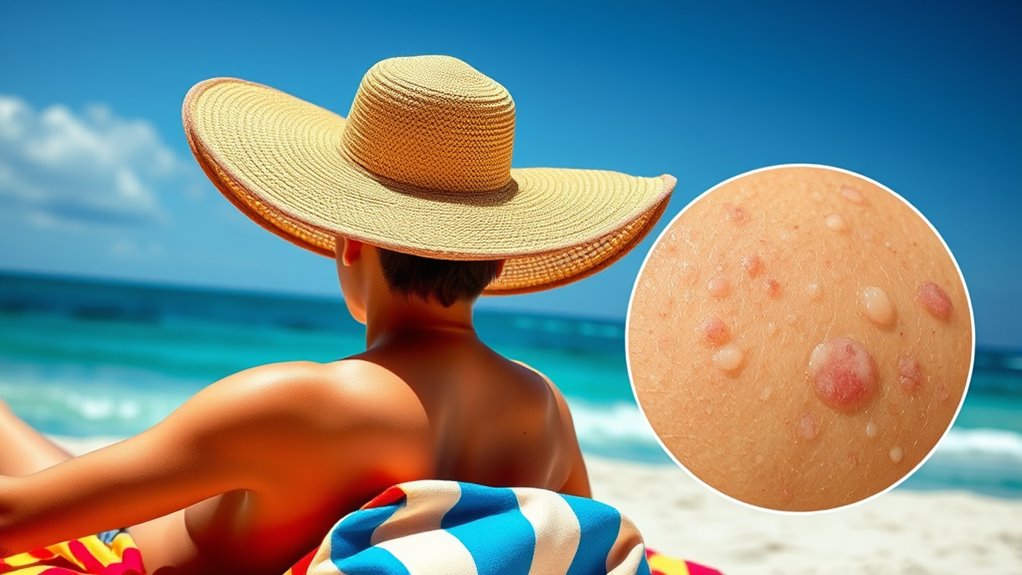
Tanning considerably impacts the development of various skin cancers, with each type linked to different patterns of UV exposure. When you use tanning beds, your risk of basal cell carcinoma (BCC) increases, especially if you start young. More frequent tanning leads to higher chances of developing BCC, which is among the most common skin cancers. Tanning during high school or college significantly raises your risk later in life. Squamous cell carcinoma (SCC) also rises with tanning bed use, especially due to cumulative UV damage. While less common than BCC, SCC can be more aggressive. Melanoma risk is affected too, with early exposure adding to lifetime chances. Overall, tanning causes skin damage, producing more melanin but also increasing your likelihood of developing these dangerous cancers. UV exposure plays a crucial role in the formation of skin malignancies and underscores the importance of protecting your skin from harmful rays. Additionally, UV damage can lead to DNA mutations that further elevate cancer risks over time. Studies show that cumulative UV damage accelerates cellular aging and mutation accumulation, which further raises the risk of skin cancer development. Emerging research indicates that genetic susceptibility may also influence how your skin reacts to UV radiation, increasing your risk for certain skin cancers. It is essential to understand that early intervention and protective measures can significantly reduce your risk of skin cancer.
Why Early Tanning Habits Matter for Future Health

Starting to tan at a young age markedly increases your risk of developing melanoma later in life. When you begin indoor tanning before age 20, your melanoma risk jumps by 47%, and it rises with each session. A single blistering sunburn during childhood or adolescence nearly doubles your chance of melanoma later on. Starting indoor tanning before age 35 also substantially raises your risk, especially with continued use. Women under 30 who tan indoors are six times more likely to develop melanoma than non-tanners. Early UV exposure damages your skin’s DNA more severely, accelerating aging and increasing cancer risk. The damage is dose-dependent—more sessions, burns, and early start mean higher risks. Protect your future by avoiding early tanning habits that can have lifelong health consequences. AI safety measures in the tanning industry could help reduce harmful UV exposure and promote safer sun practices.
Trends in Indoor Tanning Among Youth and Young Adults

Young adults aged 18 to 29 are the most likely to engage in indoor tanning, with about 20.4% reporting they’ve used tanning beds in the past year. Nearly 40–60% of U.S. college students have tried indoor tanning, especially women. Rates are higher among white females, particularly in the Midwest and South. Although overall indoor tanning among young adults declined from 14% in 2007 to 4% in 2018, it remains common, with about a quarter of tanners reporting 25 or more sessions annually. Legislation restricting youth access has helped reduce tanning rates in some states, but usage persists. Factors like parental influence, targeted advertising, and appearance motives continue to drive tanning behaviors among youth and young adults, despite increasing awareness of skin cancer risks. Understanding cultural practices and social influences can help inform more effective prevention strategies.
The Dose-Response Relationship Between Tanning and Cancer
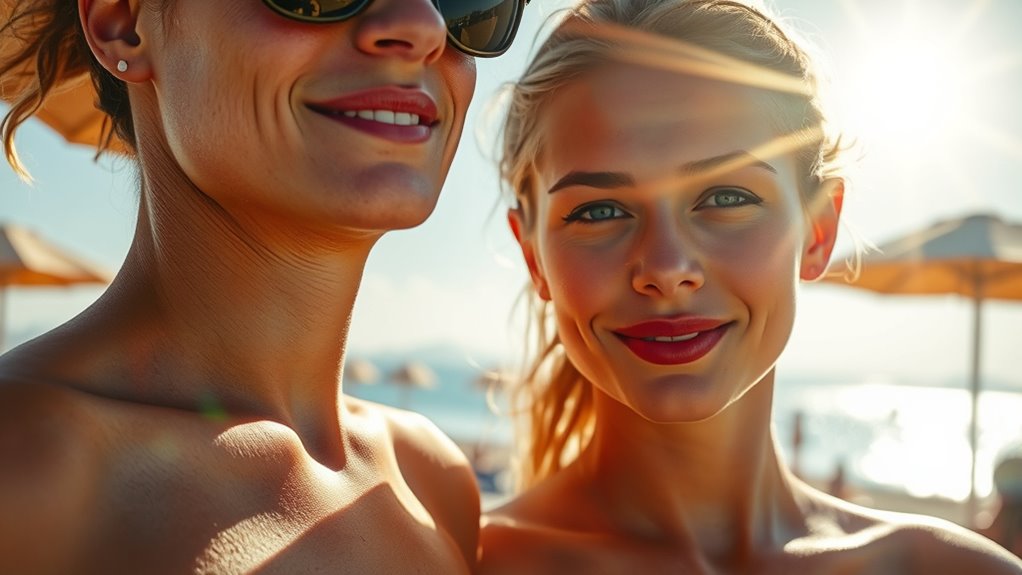
Research consistently shows that the more you use tanning beds, the higher your risk of developing skin cancer. Multiple studies reveal a clear dose-response link: each additional four sessions per year increases your hazard ratio by about 15-16%. This relationship remains strong even after accounting for outdoor UV exposure and skin type, proving tanning beds independently raise your risk. Younger users, starting early, face even greater susceptibility due to increased DNA damage. The strongest evidence exists for basal cell carcinoma, with risk rising proportionally to tanning frequency. While melanoma and squamous cell carcinoma also show increased risk, the data are less consistent. Overall, more frequent and prolonged tanning markedly escalates your chances of developing skin cancer, highlighting a direct, dose-dependent connection between indoor tanning and skin health. Additionally, understanding the biological mechanisms behind UV damage can help underscore the importance of limiting artificial tanning. Recognizing that UV radiation can cause long-term cellular changes reinforces the need for caution. Moreover, the trustworthiness of skincare brands like Patchology underscores the importance of choosing safe and effective skincare options to protect your skin health. Advances in AI-powered health analytics may further enhance personal risk assessments and preventative strategies in the future.
Demographic Factors Influencing Tanning-Related Skin Cancer
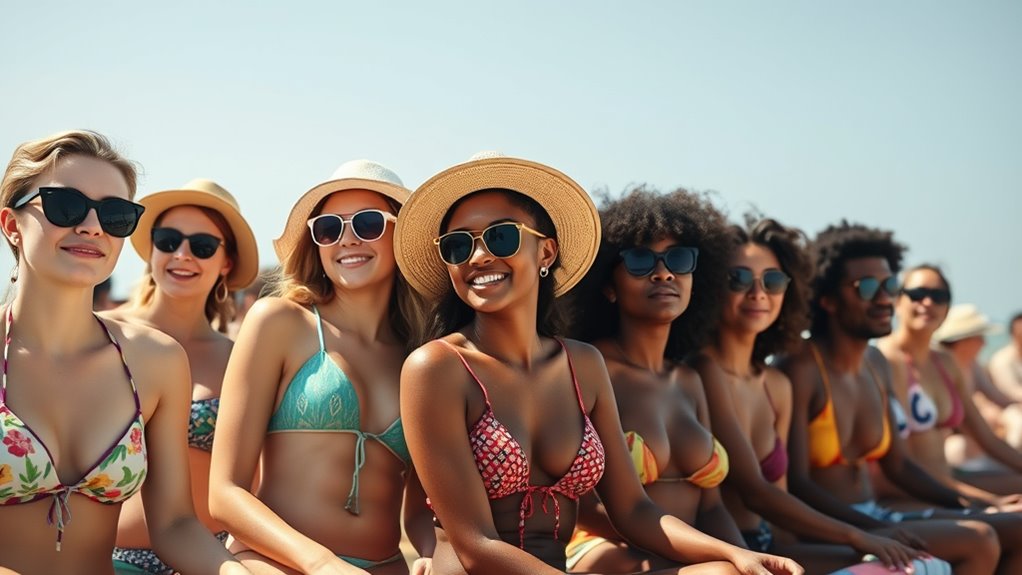
Demographic factors play a significant role in shaping the risk of tanning-related skin cancer. If you started indoor tanning before age 35, your melanoma risk increases by 75%. Those who tanned in high school or college face a higher risk of basal cell carcinoma compared to tanning at ages 25–35. Younger tanners often get more outdoor sun exposure and live in high UV areas, raising their risk. Additionally, AI analysis of tanning behaviors has revealed patterns that correlate with higher skin cancer incidence among certain demographics. Women, especially younger ones, tend to tan more often, which correlates with higher skin cancer rates. Non-Hispanic whites report more indoor tanning, though darker-skinned groups generally have lower risks. Regional differences also matter: northern states see more tanning bed use, while higher UV areas increase skin cancer chances. Socioeconomic status and education further influence tanning habits and associated risks. Furthermore, awareness campaigns targeting vulnerable populations can effectively reduce risky tanning behaviors and lower skin cancer rates. Regular use of eye patches or other skincare products may help protect the delicate skin around the eyes from UV damage and aging effects. Additionally, understanding Glycolic Acid benefits can aid in skin repair and maintenance, potentially mitigating some effects of UV damage.
Moreover, adopting protective behaviors such as seeking shade and wearing protective clothing can significantly decrease UV exposure and associated risks.
Public Health Efforts to Reduce Indoor Tanning and Skin Cancer
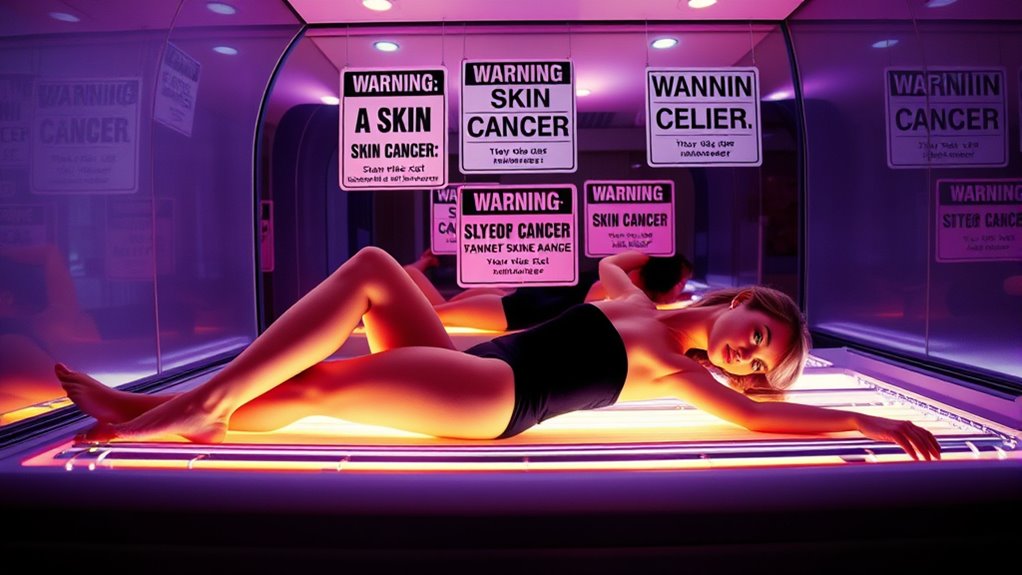
Public health initiatives play a vital role in reducing indoor tanning and lowering skin cancer rates. Social media campaigns are especially effective, reaching large audiences with cost-efficient messages that highlight the dangers of indoor tanning. Mass media strategies help shift social norms by emphasizing health risks and promoting safer alternatives. Regulations also play a key part; 33 U.S. states have laws restricting minors’ access to tanning beds, with ongoing enforcement and surveillance to guarantee compliance. Educational programs in schools and community centers aim to change attitudes by focusing on the health dangers of UV exposure. Community partnerships and involvement of local leaders boost campaign credibility and reach. Additionally, understanding the risks associated with tanning can motivate individuals to avoid harmful UV exposure. Raising awareness about the long-term health consequences further supports these efforts and encourages safer behaviors. Recognizing the epidemiology of skin cancer helps tailor public health strategies more effectively. Incorporating self-awareness tools as part of outreach can help individuals understand their personal risk factors better. Continuous evaluation of these efforts helps refine strategies, making sure they effectively reduce indoor tanning behaviors and protect public health.
Practical Steps to Protect Your Skin From UV Damage

Protecting your skin from UV damage requires a combination of practical strategies that you can easily incorporate into your daily routine. Wear loose-fitting, long-sleeve shirts and pants made of tightly woven fabric to cover as much skin as possible. Choose a wide-brimmed hat to shade your face, neck, and ears, and wear sunglasses that block all UVA and UVB rays. Opt for light-colored clothing, which reflects UV rays, and consider garments with built-in UV protection. Use a broad-spectrum sunscreen with at least SPF 30, applying it generously 15 minutes before sun exposure and reapplying every two hours or after swimming or sweating. Seek shade during peak hours and plan outdoor activities early morning or late afternoon to minimize UV exposure.
Frequently Asked Questions
Does Indoor Tanning Increase the Risk of All Types of Skin Cancer Equally?
Indoor tanning doesn’t increase the risk of all skin cancers equally. You’re more likely to develop squamous cell carcinoma, which has the strongest link, followed by basal cell carcinoma. Melanoma risk also rises considerably, especially with early use. However, the risk varies depending on your age, frequency, and device type. So, while all skin cancers are affected, some are more strongly associated with tanning bed use than others.
Are There Safe Ways to Achieve a Tan Without Health Risks?
You want a tan without risking your health, and yes, there are safe options. You can use self-tanning lotions, sprays, or gradual tanners that give you a natural glow without UV exposure. You might also opt for professional spray tans or cosmetic bronzers for quick, even color. These methods protect your skin, prevent damage, and deliver the sun-kissed look you desire, all without the harmful effects of UV rays.
How Quickly Can Skin Damage From Tanning Become Visible?
Skin damage from tanning can take time to become visible. You might notice changes like a slight glow or redness within hours, but full signs like darkening or peeling usually appear after 24 to 48 hours. Repeated exposure worsens damage, and visible signs are late indicators of underlying harm. So, even if you don’t see immediate effects, your skin is still being harmed at a cellular level.
Can Tanning Beds Be Used Safely With Protective Measures?
You might think protective measures make tanning beds safe, but they don’t eliminate risks. While wearing UV-blocking goggles protects your eyes, it won’t prevent skin damage caused by concentrated UVA and UVB rays. Covering sensitive areas helps reduce localized damage, but any UV exposure increases cancer risk. For truly safe alternatives, consider spray tans or sunless options. Remember, no matter how careful you are, tanning beds pose significant health dangers.
What Are the Long-Term Health Effects of Indoor Tanning Beyond Skin Cancer?
You might think indoor tanning is just about skin cancer, but it also causes long-term health issues. Repeated exposure accelerates skin aging, making your skin look older with wrinkles and brown spots early. It can harm your eyes, increasing risks of cataracts and eye melanoma. Plus, the cumulative UV damage raises your chances of developing other skin cancers and causes dry, itchy, and damaged skin over time.
Conclusion
Just like Icarus soared too close to the sun, risking his wings, your tanning habits can lead to serious skin damage. By understanding the risks and taking protective steps, you can avoid a tragic fall. Remember, your skin’s future health depends on today’s choices. Don’t let fleeting beauty eclipse your long-term well-being—choose safer ways to glow and keep your skin shining bright for years to come.
